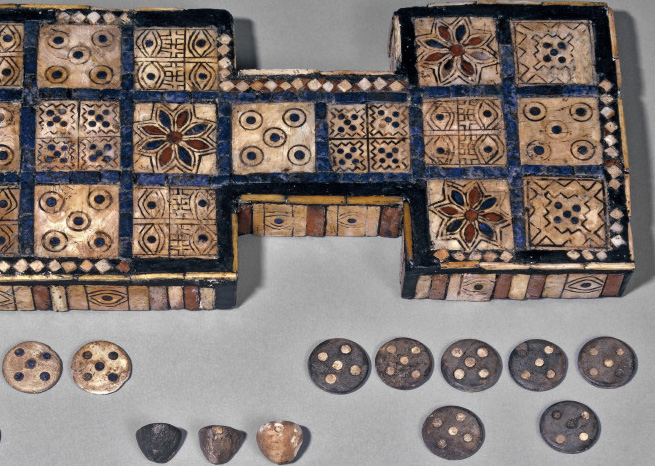Question: What was the Royal Game Of Ur?
Answer: In the ancient world, board games were as popular as they are today. Board games were very common in ancient Egypt, Mesopotamia and other parts of the world.
The Royal Game of Ur is a board game made between 2600 and 2400 BC. So it’s at least 4,400 years old! Game-board is wooden; the face is of 20 variously inlaid square shell plaques; edges made of small plaques and strips, some sculptured with an eye and some possibly with rosettes; on the back are three lines of shell triangular ornamental inlays. Its height is 2.4 centimetres.; Width: 11 centimetres; Length: 30.1 centimetres; Width: 5.7 centimetres (narrow part of b).
It was discovered in Mesopotamia (modern Iraq) in the 1920s when the British archaeologist Leonard Woolley was digging into the ruins of a long-buried royal city in a royal cemetery. Among many amazing treasures, he found several games and the Royal Game Of Ur is one of them.
Circumstances of discovery and consolidation in the field described by Leonard Woolley as follows:
“The board lay face upwards in the soil. With the decay of the wood the whole of the encrustation of the upper surface had sunk down into the void so left, while the strip-work along the sides remained sticking up above it; this collapse had resulted in the dislocation of much of the fine mosaic border, and the regularity of the surface was disturbed, the shell squares often lying at an angle and the lapis strips overlapping them; further, the end of the larger section had been broken and the three last plaques (all except the corner of that on the left, which was still attached) and the right-hand plaque of the next row lay separated from each other and half an inch or more away from the main board, and the border and edging here had been scattered.
It was this broken end that we found first and probably some pieces of the strip edging were overlooked by us; when the presence of the object was recognized we worked along it a square or so at a time, pouring hot wax over it as we went, and finally the whole was secured with waxed cloth and lifted. It has not been taken to pieces and remade. The inside was cleaned and covered with waxed muslin and the cloth and wax removed from the face and then it was placed face downwards on a sheet of glass and by applying heat we were able to push the component parts down into their places; the three loose plaques were replaced in the order in which they were found, but nothing was done to restore the missing part of the border and edging.
The red and blue spots inlaid in the shell plaques and petals of the flowers were loose in their sockets when found, but were fixed by the wax poured over them and very few of them have been disturbed and replaced
[n. A few floated up in the liquid wax but could be at once pushed down into their holes]”. The object was reconstructed by the WAA conservator, I. G. Tremayne, following sagging through a build-up of intense heat in the gallery.
The Ur-style Twenty Squares game board was also known in Egypt as ‘Asseb’, and has been found in Pharaoh Tutankhamen’s tomb, among other places. Discovery of a tablet partially describing the game play has allowed the game to be played again after over 2000 years, although reconstructions of the detailed rules have differed widely.
The Royal Game of Ur was played with two sets, one black and one white, of seven markers and three tetrahedral dice. After around 1000 BC, the layout of the twenty squares was altered to make the end course for the markers a straight line. The rules of the game as it was played in Mesopotamia are not completely known but there have been a number of reconstructions of game play, based on a cuneiform tablet of Babylonian origin dating from 177–176 BC by the scribe Itti-Marduk-Balāṭu. It is universally agreed that the Royal Game of Ur, like Senet, is a race game.*
Source: MessageToEagle.com Credit: The British Museum and Wikipedia





 wishlist(0)
wishlist(0)


